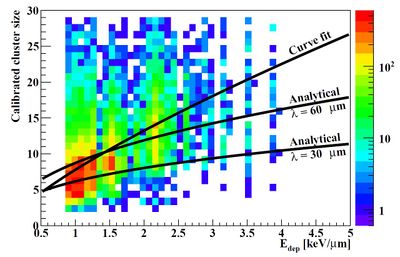WP1 Ideas for project to pursue: Difference between revisions
| Line 16: | Line 16: | ||
Intuitively, it should be possible to perform a PID (Particle ID) together with the track reconstruction in the DTC. Different particles (w/different charge) should have a different edep distribution in the epitaxial layer, giving rise to depth-dependent cluster size distributions (depth dose) of different values. The height of the plataeu region of the Bragg Curve is then the PID indicator: H, He, C, ... | Intuitively, it should be possible to perform a PID (Particle ID) together with the track reconstruction in the DTC. Different particles (w/different charge) should have a different edep distribution in the epitaxial layer, giving rise to depth-dependent cluster size distributions (depth dose) of different values. The height of the plataeu region of the Bragg Curve is then the PID indicator: H, He, C, ... | ||
This would e.g. be of help during alpha beam tests, where secondary protons from the phantom easily could be removed. | This would e.g. be of help during alpha beam tests, where secondary protons from the phantom easily could be removed. | ||
* Helge wants to further explore this idea and if good make a conference paper on this + the charge diffusion model modeled on the data we already have -- and on ALPIDE. | * Helge wants to further explore this idea and if good make a conference paper on this + the charge diffusion model modeled on the data we already have -- and/or on ALPIDE. | ||
* Bias voltage dependency..? | * Bias voltage dependency..? | ||
== Local-to-global Monte Carlo simulations for quick MLP == | == Local-to-global Monte Carlo simulations for quick MLP == | ||
Revision as of 08:18, 16 November 2017
Below is a list of ideas regarding DTC data analysis, design etc. that might be worthwhile to pursue.
Time-dependence of charge diffusion process
We see in the ALPIDE chips that the quick integration time of ~10 µs reveals a time dependence on the charge diffusion process -- i.e. that too small clusters, medium clusters and then large clusters with holes are visible. It would be interesting to see if it's possible to use the data already acquired to model the time dependency in this process.
Re-implementation of Maczewski model to analytically describe charge diffusion process
The model as it stands today looks like below, which does not accurately describe the data.
Two shortcomings of the Maczewski model (see his thesis and Even's MSc thesis) are that
- Only one term in the expansion is used (the model was used as in Maczewski's thesis)
- The Most Probable Value of the Landau distribution of Energy Deposition values in the epitaxial value was considered. This is a more serious approximation, and a new implementation should be made based on Even's code that rather samples from a Landau distribution.
PID for DTC
Intuitively, it should be possible to perform a PID (Particle ID) together with the track reconstruction in the DTC. Different particles (w/different charge) should have a different edep distribution in the epitaxial layer, giving rise to depth-dependent cluster size distributions (depth dose) of different values. The height of the plataeu region of the Bragg Curve is then the PID indicator: H, He, C, ... This would e.g. be of help during alpha beam tests, where secondary protons from the phantom easily could be removed.
- Helge wants to further explore this idea and if good make a conference paper on this + the charge diffusion model modeled on the data we already have -- and/or on ALPIDE.
- Bias voltage dependency..?

